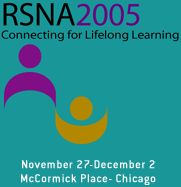
Abstract Archives of the RSNA, 2005
Tom W.J. Scheenen PhD, Presenter: Nothing to Disclose
Stefan Roell PhD, Abstract Co-Author: Nothing to Disclose
Stijn W.T.P.J. Heijmink MD, Abstract Co-Author: Nothing to Disclose
Heinz-Peter Schlemmer MD, Abstract Co-Author: Nothing to Disclose
Jelle O. Barentsz MD, Abstract Co-Author: Nothing to Disclose
Arend Heerschap PhD, Abstract Co-Author: Nothing to Disclose
To show that 3D ¹H MR spectroscopic imaging (MRSI) for prostate cancer detection can be performed with a spatial resolution of 1 cc in less than 9 minutes without the discomfort of an endorectal coil (ERC) by combining the signals of multiple surface coil elements at 3T.
15 patients with biopsy proven prostate cancer were examined with T2-weighted imaging for staging of the disease using an array of receiver coils on a 3T whole body scanner (Siemens MAGNETOM Trio) (total MR time ~20 minutes). MRSI was done in 8 min 37 s with an acquisition weighted PRESS sequence with optimized 180º pulses, frequency selective water and lipids suppression, and outer volume saturation slabs (Scheenen et al, 2005 MRM, in press). After filtering, zerofilling and fourier transformation the signals of different coil elements were combined into one spectrum for every voxel (Brown MA, 2004 MRM 52:1207-1213). The resected prostates were routinely prepared and stained with hematoxylin and eosin. One experienced pathologist who was blinded to the MR results outlined the presence and extent of cancer on whole mount sections of the prostate as the gold standard of reference.
On T2-weighted images tumor regions in the prostate were commonly visible as hypointense. In all cases MRSI showed signals of citrate, creatine, choline and polyamines throughout the prostates with a voxel volume of 1 cc, without severe baseline distortions or lipid contamination. Regional differences in relative metabolite signals were found to correspond to healthy and tumour tissue, with elevated choline levels and decreased citrate levels characterizing cancer.
3D MRSI of the human prostate with a voxel resolution of 1 cc can be done successfully at 3T with an array of surface coils in 8.5 minutes, avoiding the use of an ERC. This could be an important step towards screening for prostate cancer by MR, if T2-weighted imaging and MRSI performed in this way further proves to be a clinically useful combination in tumor detection.
S.R.: Employed by Siemens Medical Solutions
To show that 3D ¹H MR spectroscopic imaging (MRSI) for prostate cancer detection can be performed with a spatial resolution of 1 cc in less than 9 minutes without the discomfort of an endorectal coil (ERC) by combining the signals of multiple surface coil elements at 3T.
15 patients with biopsy proven prostate cancer were examined with T2-weighted imaging for staging of the disease using an array of receiver coils on a 3T whole body scanner (Siemens MAGNETOM Trio) (total MR time ~20 minutes). MRSI was done in 8 min 37 s with an acquisition weighted PRESS sequence with optimized 180º pulses, frequency selective water and lipids suppression, and outer volume saturation slabs (Scheenen et al, 2005 MRM, in press). After filtering, zerofilling and fourier transformation the signals of different coil elements were combined into one spectrum for every voxel (Brown MA, 2004 MRM 52:1207-1213). The resected prostates were routinely prepared and stained with hematoxylin and eosin. One experienced pathologist who was blinded to the MR results outlined the presence and extent of cancer on whole mount sections of the prostate as the gold standard of reference.
On T2-weighted images tumor regions in the prostate were commonly visible as hypointense. In all cases MRSI showed signals of citrate, creatine, choline and polyamines throughout the prostates with a voxel volume of 1 cc, without severe baseline distortions or lipid contamination. Regional differences in relative metabolite signals were found to correspond to healthy and tumour tissue, with elevated choline levels and decreased citrate levels characterizing cancer.
3D MRSI of the human prostate with a voxel resolution of 1 cc can be done successfully at 3T with an array of surface coils in 8.5 minutes, avoiding the use of an ERC. This could be an important step towards screening for prostate cancer by MR, if T2-weighted imaging and MRSI performed in this way further proves to be a clinically useful combination in tumor detection.
S.R.: Employed by Siemens Medical Solutions
Scheenen, T,
Roell, S,
Heijmink, S,
Schlemmer, H,
Barentsz, J,
Heerschap, A,
3D ¹H-MR Spectroscopic Imaging of the Human Prostate at 3T without an Endorectal Coil: A Step towards MR Screening of Prostate Cancer?. Radiological Society of North America 2005 Scientific Assembly and Annual Meeting, November 27 - December 2, 2005 ,Chicago IL.
http://archive.rsna.org/2005/4417751.html

